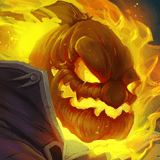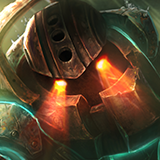/dev: Downloading PROJECT// Overcharge
Building the chase in the PROJECT// Overcharge game mode.
League’s newest gamemode, Overcharge, was our first ever exploration into expressing the universe of PROJECT through gameplay. It’s a chance to let players tangibly interact with the thematic, and from a new perspective too—it’s world removed from the shiny elegance of PROJECT we’re familiar with. For Overcharge, we journeyed down into the underbelly in search of new gameplay and a visual map style that hadn’t been tried before in League of Legends.
Gameplay Design – Kevin “Beluga Whale” Huang
From cybernetically enhanced champions with peerless precision to the process of augmenting endlessly towards perfection, the PROJECT world offers lots of unique thematic hooks. So for this project, we decided to alter our gameplay design approach and cast a wide net with rapid initial prototyping. We first spent a few weeks rapidly iterating through multiple, wildly different modes. Ultimately however, narrative’s vision of exploring the darker underworld in the PROJECT universe got us really excited to support them.
We chose to challenge ourselves to craft a game mode that was born out of this thematic. Running through dark, rainy alleyways; looking over your shoulder frantically before ducking behind a corner; scoping your target and waiting for the right moment to jump them: These are some of the things we felt when we heard narrative’s pitch. We wanted players to experience the heart-racing, adrenaline-pumping action as they just barely beat out their opponents.
We knew then that the finished product should invoke a specific sense of tension—BUT HOW???
Our first instinct was to literally create a dark alleyway. This was already an immense departure from the standard terrain players are used to. With combat spaces constricted to extremes and blind corners everywhere, playing a simple PvP deathmatch on that map certainly succeeded at creating tension. This is the benefit of having really powerful driving vision.
With such a unique idea for a map layout (for LoL at least), it was time to start developing the gameplay mechanics that would support it. A couple of different gameplay ideas were floated: zone capture, pac-man, race to a point, attack/defense… Each of these emphasized different aspects of the map and thematic. From playtests, we found that players were having the most fun with prolonged chases and hiding/stalking—conveniently but not surprisingly in line with the initial narrative drive.
We also found that the PROJECT champion pool, which was the initial pool we tested for the mode, was an extremely warped one. Basically there were marksmen (Ashe, Lucian, Jhin, Vayne), and then champions that were really good at killing marksmen, especially in tight corridors (Zed, Kat, Master Yi, Ekko, Yasuo, Vi, Fiora). And then there was Leona just chilling on the side. Not only was this pool not creating engaging combat, it also generally evolved into deathball, so we made the call to change the champion pool restriction to all marksmen instead of PROJECT champions. Sorry Vi.
From this point, it was a matter of creating mechanics to facilitate these “cat and mouse” moments. Our first approach was to just smash it with a hammer: teams literally alternated being invulnerable for 30 seconds on a set clock. This combined with the champion pool changes were fairly successful at solving out deathball. It also created lots of satisfying moments when you did manage to escape because you knew your opponent had all the advantages—you just outplayed them.
We worked on level designing the map—which is where we adjust the location of walls, brushes, and paths—to make sure there were lots of juking spots and that the map was really amplifying the gameplay loop. To that end, we iterated rapidly through lots of different terrain setups. We identified that champions with mobility would have heavy advantages in the mode, so we focused on adding built-in mobility options to help equalize the playing field.
On top of adding objects like the blast nodes for general mobility, we added teleport pads that blink you from point A to point B. This helped solve for the fact that, normally, being on the perimeter of the map would mean one or two fewer directions you could move. We knew these tools were working when we started seeing immobile champions like Jhin dodging and escaping from Sivir and Vayne.
Art – Brendon “Riot Vitzkrieg” Vitz and David “Sharkcromancer” Harrington
We started the Section 43 map with some trepidation. We wanted to immerse players in the amazing world of PROJECT, but up until this map, we’d never done a League environment in the sci-fi space.
This mood piece was the first big breakthrough for the art team. In the mood piece, David painted the platform between the glowing upper world of the original Overdrive video and the gloomy slums of The Hunt video; this location allowed us to capture both sides of a PROJECT city. With alignment around the mood we wanted to hit, everyone could focus on different sections of the Overcharge map while also knowing it’d all fit together in the end.
As the block-in of the map progressed, we began to realize it was impossible to tell how big the characters were. The buildings were too foreign to show scale, so David focused on making a series of human-scaled objects; things with handles and displays help ground the world in a scale our eyes can understand. On top of that, these small props and objects added a ton of story and believability to the world. It’s interesting to think about what people would use in their daily lives and what kind of equipment and tools they’d interact with.
In the dark gritty underbelly of the PROJECT universe, we wanted everything to feel super industrial and less delicate than the fancy high-tech city above. Everything has self-locking and anti-theft mechanisms and is made out of heavy duty material to prevent tampering. Power cables and key pads are sealed and structurally reinforced to stave off corrosion from the damp environment of the undercity.
Bringing It All Together
Once everything was placed and we had a general sense of where we wanted to put all of the major focal points, Sharkcromancer spent some time doing cohesion paintovers to further enrich the environment with visual elements of story and scale. He tried to balance the values of the play areas against non-playable areas to make the pathable terrain very clear, and he also added small-scale lights towards the bottom of the structures to make them feel truly massive. We had to (visually) cheat like crazy to get that humungous feel of the structures, but doing so worked well with the thematic of the loss of humanity and feeling insignificant in a huge industrial world. Seeing tons of repeating windows and structural shapes that seem to go down forever into the depths of the city below drove the point home, and I hope when you all play on this map, you really sense the scale of everything around you.
That’s all from us for now…happy hunting!

